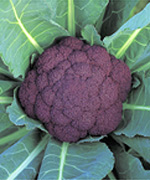 Violetta (65
days) Large purple heads on strong plants. Does well
in spring or fall.
Violetta (65
days) Large purple heads on strong plants. Does well
in spring or fall.
| HOME --> All Plants and Seeds INDEX --> Vegetables INDEX --> Cauliflower Plants and Seeds | |
| Plant and Seed Mobile Friendly Index |
Early Snowball (64 days) Old
heirloom variety produces early. 6 to 7 inch heads. Also
does well as a fall crop.
| #957 Packet $3.50 Approximately 75 seeds |
|
| #B1z-957 Bulk seeds 1 oz $10.50 |
|
| #B4z-957 Bulk seed, 4 oz $26.50 |
|
| #B1-957 Bulk seed, 1 lb. $53.50 |
|
| #P-957A One Plant in 2-1/2inch pot $4.50 |
|
 Violetta (65
days) Large purple heads on strong plants. Does well
in spring or fall.
Violetta (65
days) Large purple heads on strong plants. Does well
in spring or fall.
| #3587 Packet $3.50 Approximately 50 seeds |
|
| #Bm-3587 Bulk seeds, 1000 seeds $24.00 |
|
CULTIVATION
One of the ancient Greek Pliny's writings describe what may be an
early form of cauliflower in the first century AD.
Cauliflower made its way through Europe and later to the Americas
to become a common site in the vegetable garden. A member of
the Mustard family, Brassicaceae (or Cruciferae), it
is related to mustard, broccoli, cabbage, kale, brussel
sprouts and kohlrabi. The leaves, flower stalks and flower
heads form the 'curd' or the 'head' of the cauliflower which is
eaten as a vegetable. Heads can be white, yellow, orange,
purple or green ( also known as broccoflower).
The heads assume a number of different forms: smooth round, lumpy
round or pointed.
Cauliflower grows best in cool climates and will grow in any well
drained soil rich in humus and in a location with high
humidity. A light sandy soil that warms up quickly in the
spring is best for early crops
Cauliflower is propagated by sowing seed. The seeds may be
direct sowed or seedlings can be grown for transplants. For
transplants, sow seed in pots or trays using a fine sterile medium
(1 part sand to 2 parts sphagnum peat works very well). Sow
seed and cover to a depth of 1/4 inch. Keep moist at about
75F until seedlings emerge, then lower the temperaure to about 70F
daytime and 55 night time. When seedlings show their
first true leaves, transplant to flats or cold frames about 2-3
inches apart each way. When the weather has settled in the
spring and nighttime temperatures stay above 50F, they may be
planted outdoors. (See temperature graph below.) Plant 18-24 inches apart in rows 24-36
inches apart (The larger the mature head, the further apart
the plants should be.) Set the plants out and 'puddle'
(fill the planting hole with water) or water thoroughly after
planting. Cultivate regularly to keep weeds down and make
certain to water the plants during dry spells to prevent cracking
of the heads. A dressing of humus or leaf mold is
beneficial (or an application of a 5-10-5 fertilize, at a rate of
25lbs to 1000sq ft.) To keep the heads of white varieties
white and prevent yellowing, bend leaves over the head and tie
them with string or a rubber band to keep them in place around the
head.
To sow directly into the garden in full sun, wait until the
spring weather has settled and danger of a severe freeze has
passed. Work the soil so that it is fine. Working in
humus, peat moss or leaf mold will give the plants a boost.
Sow 1 seed every 6 inches in shallow drills in rows 24-36 inches
apart. Cover lightly to a depth of 1/4 inch. Keep the
seeds moist until they sprout, then thin seedlings to 18-24 inches
apart. Water, cultivate and fertilize as above.
HARVEST : Cut the heads when mature. Heads should be
firm, not loose. The plants will be productive until late
fall, but should be harvested before a heavy freeze. After
the central head is harvested, side shoots will produce smaller
heads. Heads should be stored on shelves at about 32F at 95%
humidity. They will remain good for about 3 weeks.
Cauliflower is a rich source of vitamins B6, C and K. It is also a
source of beneficial phytochemicals that may protect against
stomach ulcer and colon cancers. Cauliflower should be steamed or
stir fried to maintain its nutritional benefits.
Medicinally, cabbage has been used to treat constipation, an
antidote for mushroom poisoning, and to treat hangovers. An
eye wash has been made from

There is great diversity in the vegetable varieties that we offer;
which makes the general information provided only valuable as
adjustable guidelines. This may also affect your seed
planting and propagation strategies and the germination
rates under your planting conditions may vary from the seed lot
test results. The following soil temperature data is for cauliflowers
in general. Temperatures are average daytime from planting to
emergence. Percentage is average germination rate. Days is number
of days to emergence.
41ºF x 0% x 0 days; 50ºF x 58% x 20 days; 59ºF x
60% x 10 days; 68ºF x 99% x 6 days; 77ºF x 63% x 5 days;
86ºF x 45% x 5 days; 95ºF x 0% x 0 days;
ORDER EARLY!
See TERMS
Back to VARIETY INDEX
Terms HOME
![]() If you have
arrived in someone else's frame, or can not see all of the other
information available on richfarmgarden.com Click on logo to enter
from beginning
If you have
arrived in someone else's frame, or can not see all of the other
information available on richfarmgarden.com Click on logo to enter
from beginning